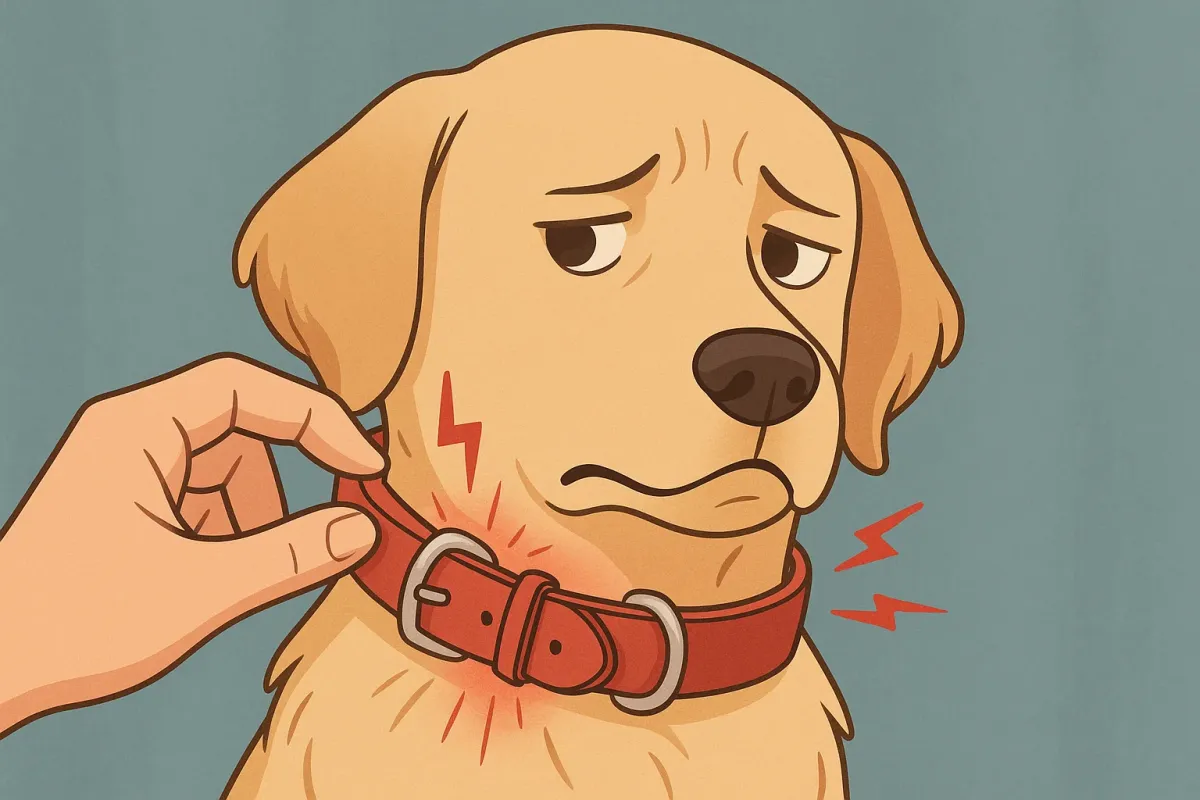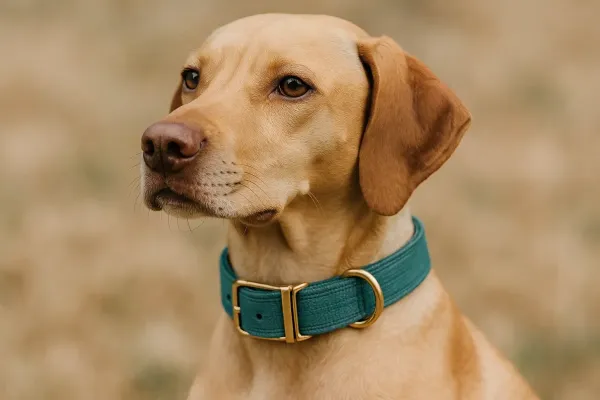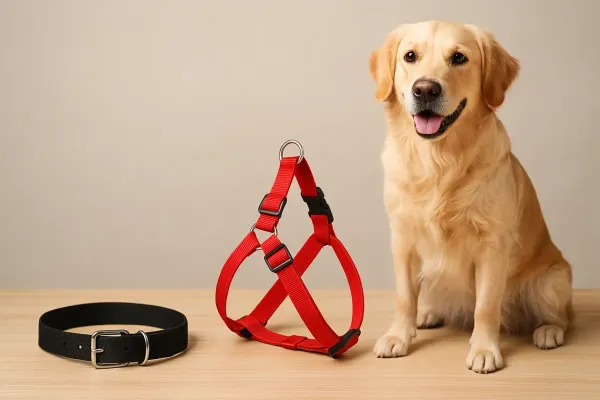
Many dog owners don’t realize that a poor-quality or badly adjusted collar can cause discomfort, irritation, and even skin injuries. Detecting these problems early is key to preventing more serious issues and ensuring your dog’s well-being.
In this guide, you’ll learn how to recognize if your dog’s collar is causing harm, what physical and behavioral signs to watch for, the most common causes, and how to choose a safe, comfortable collar for both large dogs and small dogs.
Symptoms That Your Dog’s Collar Is Causing Damage
When a collar doesn’t fit properly or is made from poor materials, dogs often show clear signs of discomfort. Recognizing these symptoms early is essential to prevent minor irritation from turning into more serious injuries.
Physical Signs
- Redness or visible irritation around the neck.
- Hair loss or bald patches under the collar.
- Wounds, scabs, or hot spots when touched.
- Bad odor or discharge — possible signs of a skin infection.
Behavioral Signs
- Your dog scratches or tries to remove the collar repeatedly.
- They avoid having it put on or back away when they see it.
- They seem anxious or uncomfortable during walks.
- They shake their head often or maintain a tense posture.
Movement Signs
- Constantly lowering their head or walking with strange postures.
- Stopping suddenly when feeling pressure on the neck or pulling backward.
- Refusing to walk on the leash or showing unusual resistance.
If you notice any of these signs, remove the collar and inspect your dog’s neck. In case of redness or open wounds, consult your veterinarian before using it again or switching to a new model.
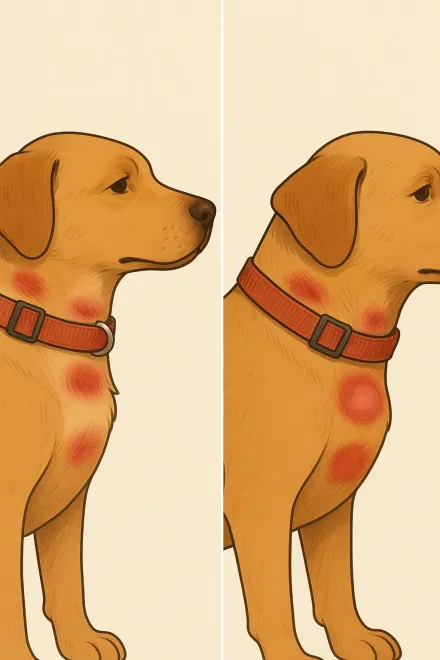
Neck Areas Most Affected by Collars
A dog’s neck is a very sensitive area, especially if they wear a collar for long periods. Injuries tend to appear where rubbing or pressure is constant.
- Behind the ears: one of the most delicate zones, easily irritated if the collar is too tight.
- Under the neck: an area prone to moisture and sweat buildup, which can lead to irritation.
- Sides of the neck: often affected in dogs that pull hard on the leash.
- Base of the neck or throat: the most dangerous spot if the collar presses the trachea or neck muscles.
These areas should be checked frequently, especially after long walks or hot days. If you see redness or hair loss, remove the collar and let the skin breathe before putting it back on.
Most Common Causes of Collar-Related Damage
In most cases, collar-related injuries are not caused by the collar itself, but by improper use or lack of care. Identifying the causes helps prevent skin irritation and neck pain.
- Collar too tight: restricts airflow, rubs the skin, and causes irritation or wounds.
- Hard or low-quality materials: plastic or synthetic leather can cause friction and overheating.
- Lack of cleaning: trapped dirt and moisture irritate the skin and encourage infections.
- Wearing it 24/7: the neck needs to rest; remove the collar at home or while your dog sleeps.
- Misplaced or twisted collar: creates uneven pressure and friction on sensitive spots.
- Pulling on the leash: repeated strain can lead to muscle injuries or tracheal damage.
Proper hygiene, a good fit, and quality materials are the key to keeping your dog’s collar safe and comfortable.
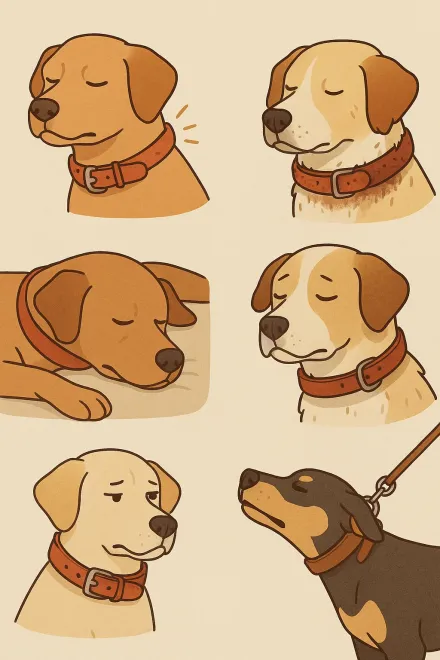
How to Choose a Collar That Won’t Hurt Your Dog
Choosing the right collar for your dog is essential to prevent discomfort or injuries. Not all models are equal — the material, width, and type of buckle all affect comfort and safety.
- Material: avoid hard plastics or synthetic materials. Opt for soft nylon, natural leather, or padded neoprene to reduce rubbing and allow the skin to breathe.
- Size: measure your dog’s neck with a flexible tape and ensure you can fit two fingers between the collar and their neck.
- Width: wider collars distribute pressure better. Thin ones are more likely to irritate the skin.
- Buckle: choose strong, secure buckles without sharp edges or metal parts that could snag the fur.
- Usage: use a sturdy collar for walks and a lighter or padded one at home or during rest.
Spending a few minutes choosing the right model can make the difference between a comfortable walk and a stressful one. A good collar should fit snugly without squeezing and move naturally with your dog.
Collar Care and Maintenance
Proper collar maintenance is key to keeping your dog comfortable and healthy. A clean, flexible, and well-maintained collar prevents irritation, bad odors, and unnecessary chafing.
- Wash it regularly: especially if your dog gets wet, sweats, or plays in muddy or sandy areas. A dirty collar traps bacteria and moisture.
- Dry it completely before putting it back on: moisture can irritate the skin and damage the material.
- Check seams and materials: inspect weekly for cracks, rough edges, or loose parts.
- Remove it at home: when your dog is resting, take the collar off to avoid friction and allow the skin to breathe.
- Replace it in time: if you notice stiffness, cracks, bad odor, or loss of flexibility, it’s time for a new one.
With simple, consistent care, your dog’s collar will last longer and stay clean, comfortable, and safe for everyday use.
Key Tips to Keep the Collar in Perfect Condition
Clean the collar regularly to prevent bacteria and unpleasant odors.
Always make sure it’s completely dry before putting it back on your dog.
Inspect stitching and materials at least once a week.
Remove the collar when your dog is at home or resting to avoid friction.
Replace it if you notice stiffness, cracks, or excessive wear in the material.
Common Mistakes When Using a Collar
Many dog owners unknowingly make small mistakes that end up causing discomfort. Here are the most frequent ones:
- Leaving the collar too tight: this can restrict breathing and cause constant neck irritation.
- Using decorative collars with no real function: some are purely aesthetic and not meant for daily use.
- Choosing cheap materials without padding: hard or synthetic edges can rub and damage the skin.
- Not checking your dog’s skin regularly: routine inspection helps detect irritation before it worsens.
- Thinking “the tighter, the more control”: excessive pressure only causes pain and stress during walks.
Incorrect collar use can cause not only physical pain but also make your dog associate walks with a negative experience. Using it properly is essential for their comfort and for calm, enjoyable walks together.
Tips to Prevent Future Problems
A few simple habits can make all the difference between a comfortable collar and one that causes irritation. Prevention is always better than cure — these tips will help keep your dog’s neck healthy and irritation-free:
- Remove the collar at night or when your dog is at home to let the skin breathe and avoid friction.
- Keep the collar clean and dry at all times; moisture and dirt lead to bad odors and irritation.
- If your dog has long hair, make sure it doesn’t get caught in the buckle or seams.
- Replace the collar as your dog grows or becomes more active — a good fit can change over time.
- Watch for changes in behavior or skin condition: if your dog scratches excessively, or you notice redness or hair loss, check the fit or switch collars.
These simple daily habits ensure more comfortable and safer walks, helping your dog stay healthy and happy.

When to See the Veterinarian
Although most collar-related issues can be solved at home with cleaning and rest, some cases require a visit to the veterinarian to prevent complications.
- Open wounds or bleeding: these can become infected quickly if left untreated.
- Pain when touching the neck: could indicate inflammation or a muscle strain.
- Hair loss or persistent bad odor: clear signs of irritation or a skin infection.
- Difficulty swallowing or breathing: the collar may be pressing on the trachea or sensitive muscles.
- Refusal to wear the collar even after adjusting it: may indicate discomfort or pain that needs professional attention.
At the first sign of these symptoms, act quickly. A veterinarian can identify the cause and recommend the best treatment to relieve discomfort and prevent further damage.
Conclusion
A well-fitted and good-quality collar not only improves your dog’s comfort but also prevents wounds, chafing, and unnecessary irritation. Most issues come from neglect or simply not recognizing early warning signs, which is why observation and care are essential.
Regularly checking your dog’s neck, keeping the collar clean, and ensuring it’s not too tight are simple steps that guarantee daily comfort. A collar should never be a source of pain — it should be a safe and comfortable tool for your walks together.
In short, listen and observe your dog: if they scratch, whine, or seem uncomfortable, they’re probably telling you something isn’t right. Your attention and care make all the difference in their happiness and health.
Frequently Asked Questions About Dog Collar Use
Is it bad for my dog to wear a collar all day?
Yes, it’s not recommended for dogs to wear a collar 24/7. Remove it when they’re at home or resting to prevent rubbing, irritation, and to let the skin breathe.
How often should I check my dog’s neck?
Check your dog’s neck at least once a week or after long walks. Look for redness, hair loss, or small wounds under the collar.
How do I know if the collar is too tight?
A well-fitted collar should allow you to slide two fingers between the collar and the neck. If you can’t do that easily or see marks on the skin, it’s too tight.
What are the most comfortable collar materials?
Collars made from soft nylon, natural leather, or padded neoprene are the most comfortable and breathable. Avoid hard plastics or rigid stitching.
How should I clean my dog’s collar?
Wash it with warm water and mild soap, rinse thoroughly, and let it dry completely before putting it back on. Avoid harsh chemicals or using it while damp.
When should I replace my dog’s collar?
Replace it when you notice cracks, stiffness, bad odor, or signs of wear. Also, change it if your dog has grown or the fit has changed.
Can a collar damage a dog’s trachea?
Yes, especially if your dog pulls hard on the leash or if the collar is too tight. In those cases, use a wider collar or consider a different harness type.
Is it normal for my dog to scratch after putting on the collar?
A little scratching is normal at first, but if it continues or you see redness, remove the collar and inspect the skin.
Can I use the same collar for walks and at home?
It’s better not to. Use a sturdy collar for walks and a light or padded one for home, or simply remove it while your dog is resting.
What should I do if the collar has already caused a wound?
Remove it immediately, clean the area with water and mild soap, and let it heal. If there’s swelling or bad odor, see a vet to prevent infection.

